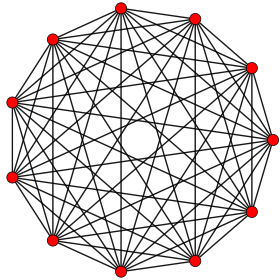| Regular hendecaxennon (10-simplex) | |
|---|---|
 Orthogonal projection inside Petrie polygon | |
| Type | Regular 10-polytope |
| Family | simplex |
| Schläfli symbol | {3,3,3,3,3,3,3,3,3} |
| Coxeter-Dynkin diagram | |
| 9-faces | 11 9-simplex |
| 8-faces | 55 8-simplex |
| 7-faces | 165 7-simplex |
| 6-faces | 330 6-simplex |
| 5-faces | 462 5-simplex |
| 4-faces | 462 5-cell |
| Cells | 330 tetrahedron |
| Faces | 165 triangle |
| Edges | 55 |
| Vertices | 11 |
| Vertex figure | 9-simplex |
| Petrie polygon | hendecagon |
| Coxeter group | A10 [3,3,3,3,3,3,3,3,3] |
| Dual | Self-dual |
| Properties | convex |
In geometry, a 10-simplex is a self-dual regular 10-polytope. It has 11 vertices, 55 edges, 165 triangle faces, 330 tetrahedral cells, 462 5-cell 4-faces, 462 5-simplex 5-faces, 330 6-simplex 6-faces, 165 7-simplex 7-faces, 55 8-simplex 8-faces, and 11 9-simplex 9-faces. Its dihedral angle is cos−1(1/10), or approximately 84.26°.
It can also be called a hendecaxennon, or hendeca-10-tope, as an 11-facetted polytope in 10-dimensions. The name hendecaxennon is derived from hendeca for 11 facets in Greek and -xenn (variation of ennea for nine), having 9-dimensional facets, and -on.